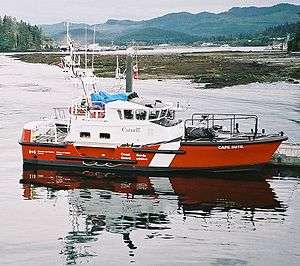CCGS Cape Commodore
CCGS Cape Commodore is one of the Canadian Coast Guard's 36 Cape-class motor lifeboats.[1] The vessel was built in Victoria Shipyards, in Vancouver, British Columbia and was stationed in Tobermory, Ontario, in September 2005.
 CCGS Cape Sutil | |
| History | |
|---|---|
| Name: | Cape Commodore |
| Namesake: | Cape Commodore |
| Operator: | Canadian Coast Guard |
| Port of registry: | Ottawa, Ontario |
| Builder: | Victoria Shipyards, Victoria, British Columbia |
| Yard number: | 826367 |
| Christened: | 2005 |
| Homeport: | CCG Base Amherstburg, Ontario - Central and Arctic Region |
| Identification: |
|
| Status: | in active service |
| General characteristics | |
| Class and type: | Cape-class motor lifeboat |
| Tonnage: | |
| Length: | 14.6 m (47 ft 11 in) |
| Beam: | 4.27 m (14 ft 0 in) |
| Draught: | 1.37 m (4 ft 6 in) |
| Propulsion: | 2 × diesel electric engines, 675 kW (905 hp) |
| Speed: | 22 knots (41 km/h) cruise |
| Range: | 200 nmi (370 km) |
| Endurance: | 1 day |
| Complement: | 4 |
Design
Like all Cape-class motor lifeboats, Cape Commodore has a displacement of 20 short tons (18 t), a total length of 47 feet 11 inches (14.61 m) and a beam of 14 feet (4.3 m).[2] Constructed from marine-grade aluminium, it has a draught of 4 feet 6 inches (1.37 m). It contains two computer-operated Detroit DDEC-III 6V-92TA diesel engines providing a combined 870 shaft horsepower (650 kW). It has two 28 by 36 inches (710 mm × 910 mm) four-blade propellers, and its complement is four crew members and five passengers.[2]
The lifeboat has a maximum speed of 25 knots (46 km/h; 29 mph) and a cruising speed of 22 knots (41 km/h; 25 mph). Cape-class lifeboats have fuel capacities of 400 US gallons (1,500 l; 330 imp gal) and ranges of 200 nautical miles (370 km; 230 mi) when cruising.[2] Cape Commodore is capable of operating at wind speeds of 50 knots (93 km/h; 58 mph) and wave heights of 30 feet (9.1 m). It can tow ships with displacements of up to 150 tonnes (170 short tons) and can withstand 60-knot (110 km/h; 69 mph) winds and 20-foot (6.1 m)-high breaking waves.[2]
Communication options include Raytheon 152 HF-SSB and Motorola Spectra 9000 VHF50W radios, and a Raytheon RAY 430 loudhailer system.[2] The boat also supports the Simrad TD-L1550 VHF-FM radio direction finder. Raytheon provides a number of other electronic systems for the lifeboat, including the RAYCHART 620, the ST 30 heading indicator and ST 50 depth indicator, the NAV 398 global positioning system, a RAYPILOT 650 autopilot system, and either the R41X AN or SPS-69 radar systems.[2]
References
- Theresa Nichols (2005-09-14). "Paul Steckle Announces the Dedication of the Cape Commodore in Tobermory, Ontario". Canadian Coast Guard. Archived from the original on 2010-01-05.
- "Motor Life Boat 47-Foot MLB: International Affairs (CG-DCO-I)". United States Coast Guard, Department of Homeland Security. 1 July 2015. Retrieved 19 August 2015.